Drake G.W.F. (editor) Handbook of Atomic, Molecular, and Optical Physics
Подождите немного. Документ загружается.

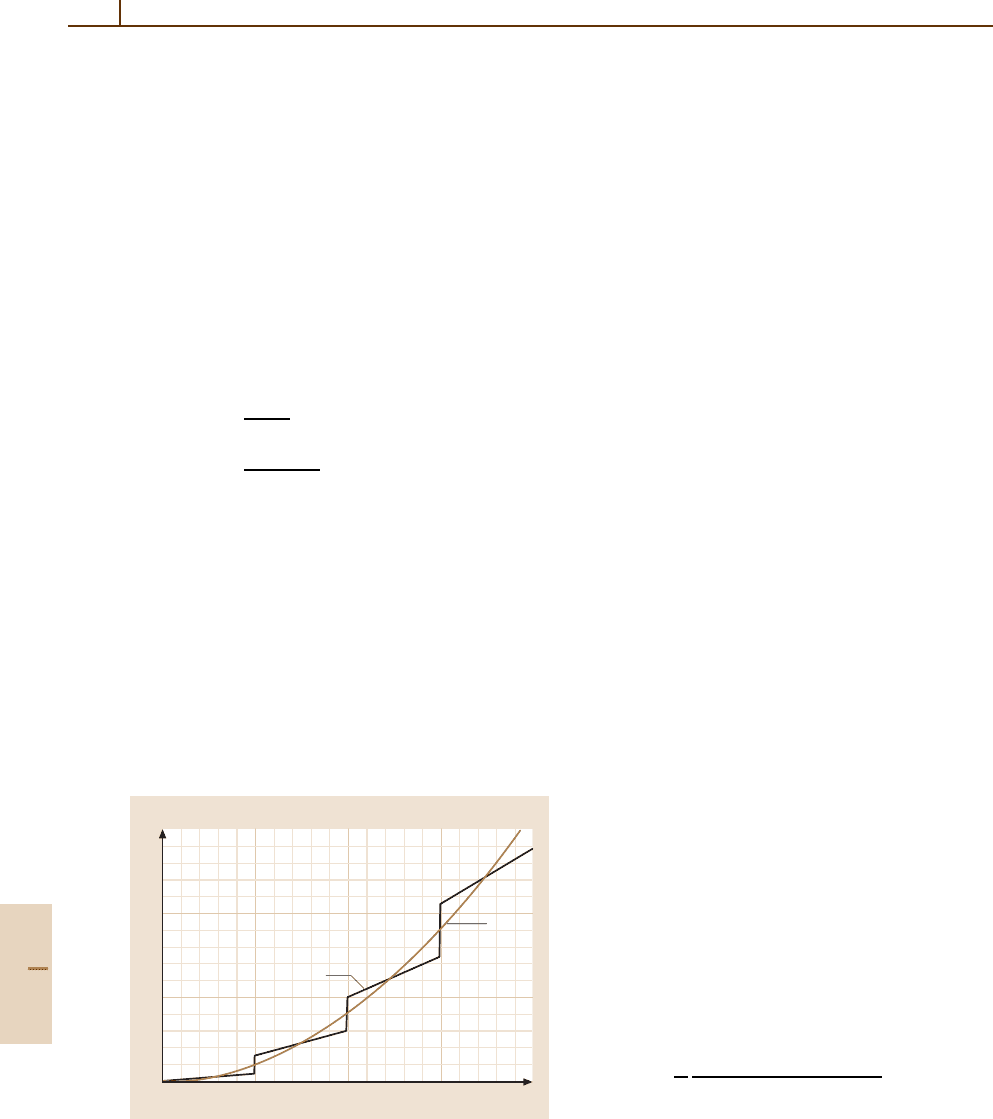
1170 Part F Quantum Optics
cording to (79.16), the theoretical problem is reduced to
a geometric evaluation of mode densities. Between a pair
of mirrors it is convenient to distinguish TE
nk
and TM
nk
modes, where n is the number of half waves across the
gap of width d. The dispersion relation ω(k) reflects the
discrete standing wave part (nπ/d) and a running wave
part as in free space,
ω
2
n,k
= c
2
|k|
2
+nπ/d
2
n = 0, 1, 2,... TM
n = 1, 2,... TE .
(79.19)
The average mode density [du = 1, (79.13)] is evaluated
[(79.17), ν = 2] with an appropriate quantization volume
containing the area of the plates, V = Ad,giving
ρ
TE
(ω) =
ω
c
[ω]
2ω
2
c
ρ
free
(ω
c
),
ρ
TM
(ω) =
ω
c
[ω +1]
2ω
2
c
ρ
free
(ω
c
), (79.20)
where [x] is the largest integer in x,andω
c
= πc/d
gives the waveguide cutoff frequency. Below ω
c
,the
TE-mode density clearly vanishes and, with the pic-
torial notion of turning off the vacuum introduced by
Kleppner [79.10], inhibition of radiative decay is obvi-
ous. Figure 79.2 shows the calculated mode density for
a parallel plate waveguide. The decay rate can be cal-
culated from (79.16), with the spatial variation of g
µ
included. This configuration was used for the first ex-
periments which showed the suppression of spontaneous
emission in both the microwave and the near optical
frequency domain [79.11,12] with atomic beams.
15
10
5
0
01234
(ω – ω
0
)
free
(ω
0
)
ρ
ρ
/
ρ
cav
ρ
free
Fig. 79.2 Modification of the average vacuum spectral
density (ρ
TE
+ρ
TM
) in a parallel plate cavity (thick line)
compared with free space (thin line)
79.2.2 Trapped Radiating Atoms
and Their Mirror Images
Boundary conditions imposed by conductive surfaces
may also be simulated by appropriately positioned image
charges. Inspired by classical electrodynamics, this im-
age charge model can be successfully used to determine
the modifications of radiative properties in confined
spaces. In the simplest case, an atom is interacting with
its image produced by a plane mirror. Trapped atoms
and ions allow one to control their relative position with
respect to a mirror to distances below the wavelength of
light. Hence they are ideal objects for studying the spa-
tial dependence of the mirror induced modifications of
their radiative properties. In an experiment with a sin-
gle trapped ion (see Fig. 79.3), its radiation field was
superposed onto its mirror image [79.13, 14], yielding
a sinusoidal variation of both the spontaneous decay rate
and the mirror induced level shift with excellent contrast.
79.2.3 Radiating Atoms in Resonators
Resonators
In a resonator, the electromagnetic spectrum is no longer
continuous and the discrete mode structure can also
be resolved experimentally. While a resonator is only
weakly coupled to external electromagnetic fields, it still
interacts with a large thermal reservoir through currents
induced in its walls. The total damping rate is due to
resistive losses in the walls (κ
wall
) and also due to trans-
mission at the radiation ports, 1/τ
µ
= κ
µ
= κ
wall
+κ
out
.
An empty resonator stores energy for times
τ
µ
= Q/ω
µ
, (79.21)
and the power transmission spectrum is a Lorentzian
with width ∆ω
µ
= ω
µ
/Q
µ
. The index µ, for instance,
represents the TE
lm
and TM
lm
modes of a “pillbox”
microwave cavity, or the TEM
klm
modes of a Fabry–
Perot interferometer (Fig. 79.4).
When cavity damping remains strong, Γ
µ
Γ
eg
,
the atomic radiation field is “immediately” absorbed and
Weisskopf–Wigner perturbation theory remains valid. In
this so-called bad cavity limit, resonator damping can be
accounted for by an effective mode density of Lorentzian
width ∆ω
µ
for a single isolated mode,
ρ
µ
(ω) =
1
π
ω
µ
/2Q
µ
(ω −ω
µ
)
2
+(ω
µ
/2Q
µ
)
2
. (79.22)
Bad and Good Cavities
The modification of spontaneous decay is again cal-
culated from (79.16). For an atomic dipole aligned
Part F 79.2
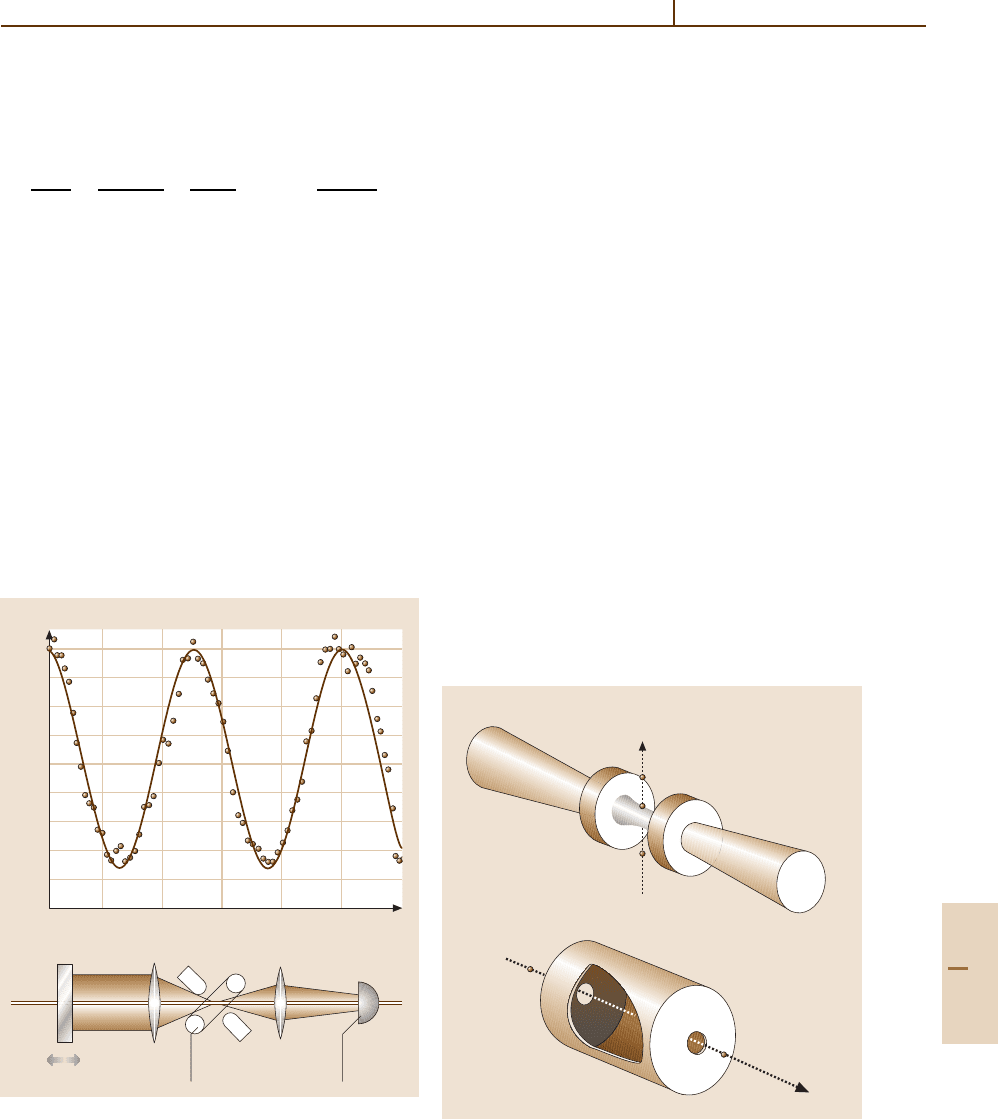
Entangled Atoms and Fields: Cavity QED 79.2 Weak Coupling in Cavity QED 1171
parallel to the mode polarization, and right at resonance,
ω
µ
= ω
0
, the enhancement of spontaneous emission is
found to be proportional to the Q-value of a selected
resonator mode:
Γ
cav
eg
Γ
free
eg
=
ρ
µ
|u(r)|
ρ
free
=
3Qλ
3
4π
2
V
|
u(r)
|
2
=
3Qλ
3
4π
2
V
eff
,
(79.23)
where the effective mode volume is V
eff
= V/|u(r)|
2
.
The lowest possible value V
eff
λ
3
is obtained for
ground modes of a closed resonator. For an atom
located at the waist of an open Fabry–Perot cav-
ity with length L, it is much larger. Special limiting
cases for concentric and confocal cavities are V
conc
eff
= λ
2
L(R/D) and V
conf
eff
= λL
2
/2π, respectively, where
(R/D) gives the ratio of mirror radius to cavity
diameter.
At resonance, the atomic decay rate Γ
µ
grows with
Q
µ
, whereas the resonator damping time constant κ
µ
is reduced. Eventually, the energy of the atomic radia-
tion field is stored for such a long time that reabsorption
becomes possible. Perturbative Weisskopf–Wigner the-
1800
1600
1400
1200
1000
800
600
400
200
0
Mirror shift (nm)
–200 –100 0 100 200
493-nm photon counts in 0.2 s
Movable mirror Ion trap Detector
Fig. 79.3 Sinusoidal variation of the λ = 493 nm sponta-
neous emission rate of a single trapped Ba ion caused by
self-interference from a retroreflecting mirror. The experi-
mental arrangement is sketched at the bottom [79.13]
ory is no longer valid in this good cavity limit, which is
separated from the regime of bad cavities by the more
formal condition
Γ
cav
eg
>κ
µ
. (79.24)
The strong coupling case is considered explicitly
in Sect. 79.3.
Antenna Patterns
Since the reflected radiation field of an atomic radiator
is perfectly coherent with the source field, the combined
radiation pattern modifies the usual dipole distribution
of a radiating atom. The new radiation pattern can be un-
derstood in terms of antenna arrays [79.15]. For a single
atomic dipole in front of a reflecting mirror for example,
one finds a quadrupole type pattern due to the super-
position of a second, coherent image antenna. In some
of the earliest experimental investigations on radiat-
ing molecules in cavities, modifications of the radiation
pattern were observed [79.16].
79.2.4 Radiative Shifts and Forces
When the radiation field of an atom is reflected back
onto its source, an energy or radiative shift is caused by
the corresponding self polarization energy. An atom in
a)
b)
Open resonator
Closed resonator
Fig. 79.4a,b Two frequently used resonator types for cav-
ity QED:
(a) Open Fabry–Perot optical cavity. (b) Closed
“pillbox” microwave cavity
Part F 79.2
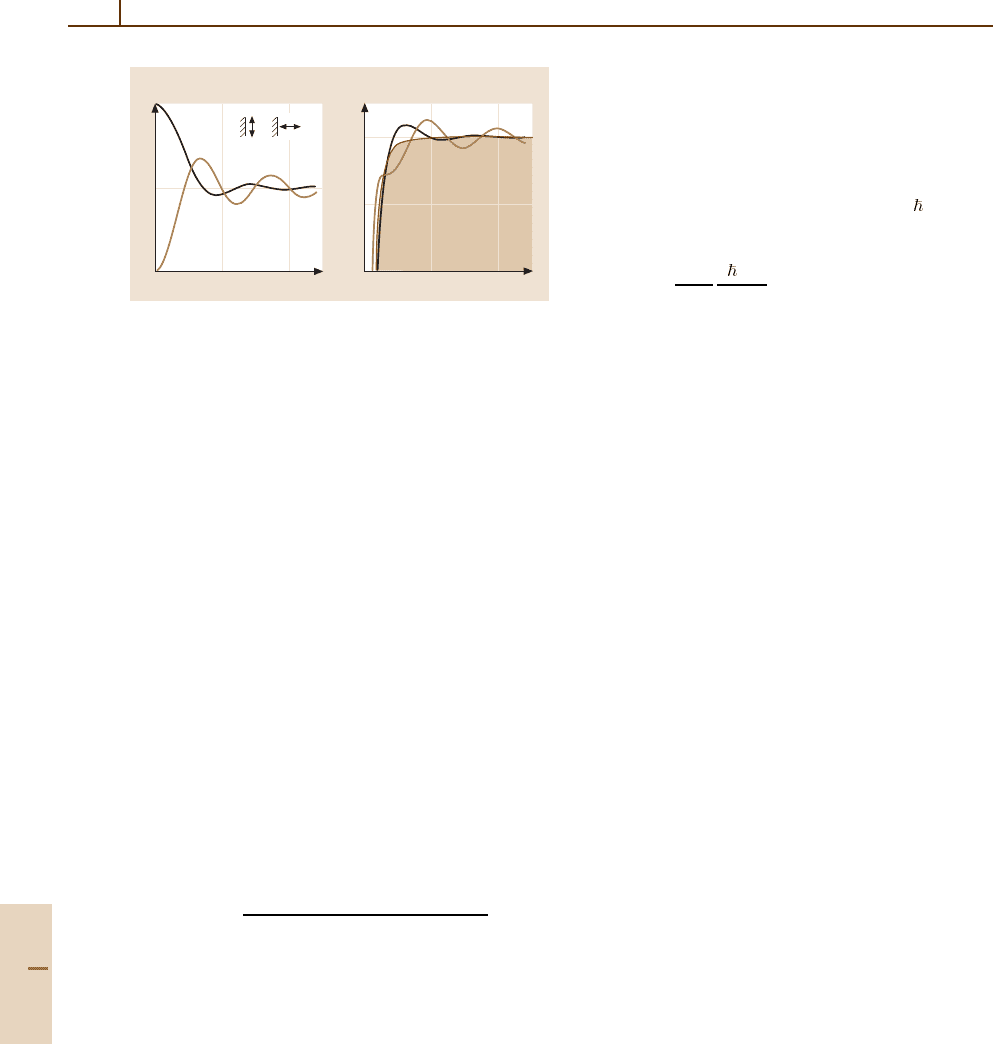
1172 Part F Quantum Optics
012
0
–0.5
1
012
2
1
0
a)
2z/λ
Γ
cav
/Γ
free
π
σ
σ
π
b)
2z/λ
π
σ
∆
cav
/Γ
free
Fig. 79.5 (a) Normalized rate of modified spontaneous
emission in the vicinity of a perfectly reflecting wall for
σ and π orientation of the radiating dipole.
(b) Cor-
responding energy shift of the resonance frequency.
Shaded area indicates contribution of static van der Waals
interaction
the vicinity of a plane mirror (Fig. 79.5)againmakes
a simple model system. Since the energy shift de-
pends on the atom wall separation z, it is equivalent
to a dipole force F
dip
whose details depend on the
role of retardation. Here we distinguish between the
two cases where no radiation energy is exchanged be-
tween the atom and the field (van der Waals, Casimir
forces) and where the atomic radiation causes forces by
self-interference.
The Unretarded Limit: van der Waals Forces
When the radiative round trip time t
r
= 2z/c is short
compared with the characteristic atomic revolution
period 2π/ω
eg
, retardation is not important. In this qua-
sistatic limit, van der Waals energy shifts for decaying
atomic dipoles vary as z
−3
with the atom–wall separa-
tion. Such a shift is also present for a nonradiating atom
in its ground state. In perturbation theory, the van der
Waals energy shift of an atomic level |a is
∆
vdW
=−
a|q
2
(d
2
· x
t
)
2
+2(d
2
·z )
2
|a
64π
0
z
3
.
(79.25)
Since the van der Waals force is anisotropic for elec-
tronic components parallel (z ) and perpendicular (x
t
)
to the mirror normal, the degeneracy of magnetic sub-
levels in an atom is lifted near a surface. The total energy
shift is ≈ 1 kHz for a ground state atom at 1 µm sepa-
ration, and very difficult to detect. However, the energy
shifts grow as n
4
since the transition dipole moment
scales as n
2
. With Rydberg atoms, van der Waals energy
shifts have been successfully observed in spectroscopic
experiments [79.17].
The Retarded Limit: Casimir Forces
At large separation, retardation becomes relevant, since
the contributions of individual atomic oscilllation fre-
quencies in (79.25) cancel by dephasing, thus reducing
the ∆
vdW
. A residual Casimir–Polder [79.18]shiftmay
be interpreted as the polarization energy of a slowly fluc-
tuating field with squared amplitude
E
2
= 3
c/64
0
z
4
originating from the vacuum field noise
∆
CP
=−
1
4π
0
3 cα
st
8πz
4
, (79.26)
where α
st
is the static electric polarizability. The vacuum
field noise ∆
CP
replaces ∆
vdW
at distances larger than
characteristic wavelengths, and is even smaller. Only
indirect observations have been possible to date, relying
on a deflection of polarizable atoms by this force [79.19,
20]. The Casimir–Polder force can also be regarded as an
ultimate, cavity induced consequence of the mechanical
action of light on atoms [79.21]. It is an example of the
conservative and dispersive dipole force which is even
capable of binding a polarizable atom to a cavity [79.22].
Radiative Self-Interference Forces
Spontaneous emission of atoms in the vicinity of a re-
flecting wall also provides an example of cavity induced
modification of the dissipative type of light forces, or
radiation pressure. If the returning field is reabsorbed,
the spontaneous emission rate is reduced and a re-
coil force directed away from the mirror is exerted.
If the returning radiation field causes enhanced decay,
a recoil towards the mirror occurs due to stimulated
emission.
If the photon is detected at some angle with respect to
the normal vector connecting the atom with the mirror
surface, two paths for the photon are possible: It can
reach a detector directly, or following a reflection off the
wall. At small atom–mirror separation these paths are
indistinguishable, the atom is thus left in a superposition
of two recoil momentum states.
79.2.5 Experiments on Weak Coupling
Perhaps the most dramatic experiment in weak coupling
cavity QED is the total suppression of spontaneous emis-
sion. For the experiments which have been carried out
with Rydberg atoms and for a low-lying near infrared
atomic transition [79.11, 12], it is essential to prepare
atoms in a single decay channel. In addition, the atoms
must be oriented in such a way that they are only cou-
pled to a single decay mode (see the model waveguide
Part F 79.2

Entangled Atoms and Fields: Cavity QED 79.3 Strong Coupling in Cavity QED 1173
in Fig. 79.4). This may be interpreted as an anisotropy
of the electromagnetic vacuum, or as a specific antenna
pattern.
An important problem in detecting the modifi-
cation of radiative properties – changes in emission
rates as well as radiative shifts – arises from their
inhomogeneity due to the dependence on atom–wall
separation. This difficulty has been overcome by control-
ling the atom–wall separation at microscopic distances
through light forces [79.17], or by using well localized
trapped ions [79.13, 14]. Furthermore, spectroscopic
techniques that are only sensitive to a thin layer of sur-
face atoms [79.23] have been used to clearly detect van
der Waals shifts.
An atom emitting a radiation field in the vicinity
of a reflecting wall will experience an additional dipole
optical force caused by its radiation field. This force has
been observed as a modification of the trapping force
holding an ion at a fixed position with respect to the
reflector [79.24].
Conceptually most attractive and experimentally
most difficult to detect is the elusive Casimir interaction.
Only for atomic ground states is this effect observ-
able, free from other much larger shifts. The influence
of the corresponding Casimir force on atomic motion
has been observed in a variant of a scattering experi-
ment, confirming the existence of this force in neutral
atoms [79.19, 20].
The success of this experiment shows that spectro-
scopic techniques involving the exchange of photons
are not suitable for the Casimir problem. A notable ex-
ception could be Raman spectroscopy of the magnetic
substructure in the vicinity of a surface. In general,
scattering or atomic interferometry experiments are
more promising methods. The experiment by Brune
et al. [79.25] may be interpreted in this way.
79.2.6 Cavity QED and Dielectrics
There are two variants of dielectric materials employed
to study light-matter interaction in confined space:
Conventional materials such as glass or sapphire, and
artificial materials called photonic materials or meta-
materials.
While dielectric materials are theoretically more dif-
ficult to treat than perfect mirrors, since the radiation at
least partially enters the medium, they have a similar in-
fluence on radiative decay processes. One new aspect is,
however, the coupling of atomic excitations to excita-
tions of the medium, which was observed for the case of
a surface-polariton in [79.26].
Cavities with dimensions comparable to the wave-
length promise the most dramatic modification of
radiative atomic properties, but micrometer sized cav-
ities for optical frequencies with highly reflecting
walls are difficult to manufacture. So-called whisper-
ing gallery modes of spherical microcavities [79.27]
have been intensely studied, but no simple way of cou-
pling atoms to these resonator modes has been found
yet.
On the other hand, dielectric materials with a peri-
odic modulation of the index of refraction may exhibit
photonic bandgaps in analogy with electronic bandgaps
in periodic crystals [79.28,29]. Electronic phenomena of
solid state physics can then be transferred to photons. For
example, excited states of a crystal dopant or a quantum
dot cannot radiate into a photonic bandgap, the radia-
tion field cannot propagate, and the excitation energy
remains localized. The bandgap behaves like an empty
resonator, and if a resonator structure is integrated into
the device, the regime of strong coupling [79.30,31] can
be achieved with such photonic structures. An overview
of suitable systems can be found in [79.32].
79.3 Strong Coupling in Cavity QED
Strong coupling of atoms and fields is realized in a good
cavity when Γ
µ
<Γ
eg
(79.24). The Hilbert space of the
combined system is then the product space of a single
two-level atom and the countable set of Fock-states of
the field,
H = H
atom
⊗H
field
, (79.27)
which is spanned by the states
|n;a=|n|a .
(79.28)
The interaction of a single cavity mode with an iso-
lated atomic resonance is now characterized by the Rabi
nutation frequency, which gives the exchange frequency
of the energy between atom and field. For an amplitude
E corresponding to n photons,
Ω(n) = g
µ
√
n +1 . (79.29)
This is the simplest possible situation of a strongly
coupled atom–field system. The new energy eigenvec-
tors are conveniently expressed in the dressed atom
Part F 79.3
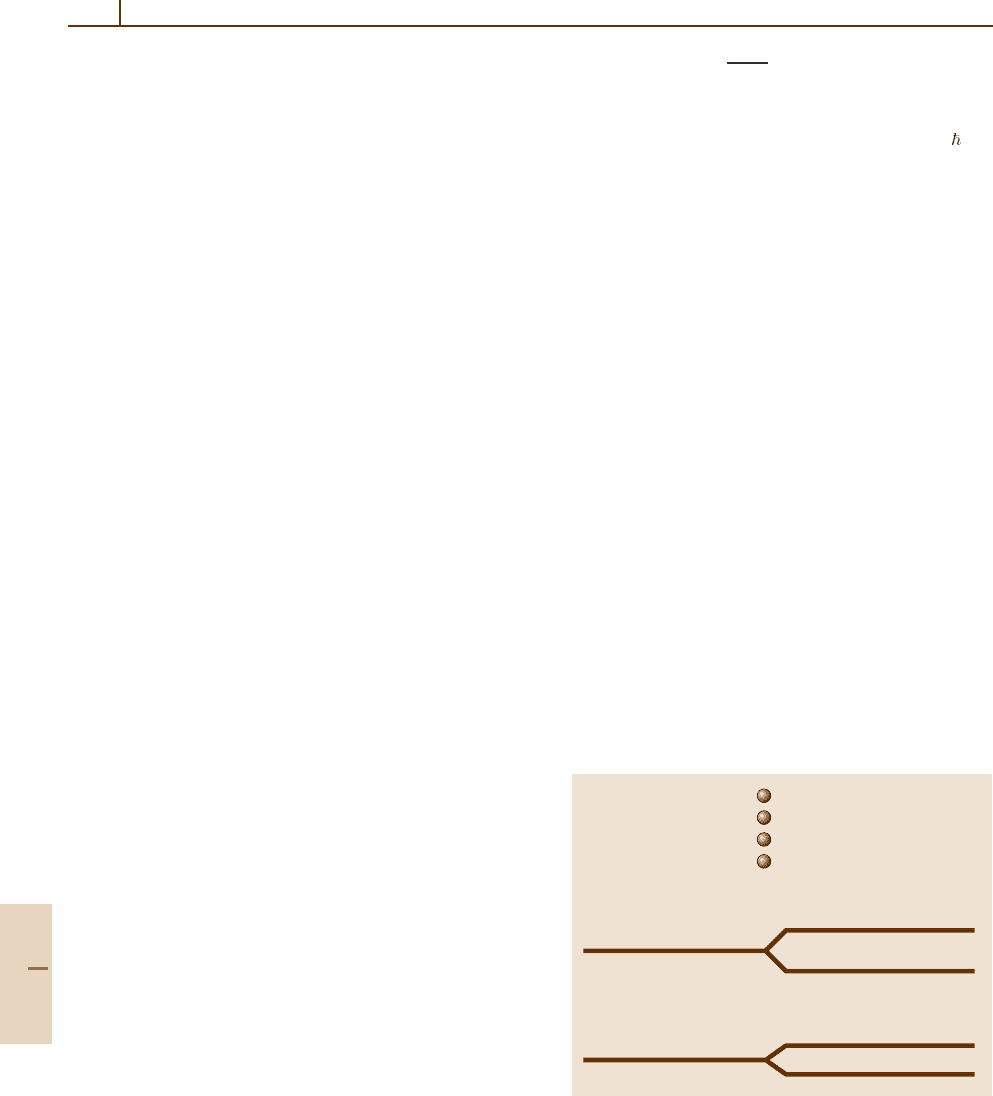
1174 Part F Quantum Optics
model [79.33]:
|+, n=cos θ|g, n+1+sin θ|e, n ,
|−, n=−sin θ|g, n +1+cos θ|e, n ,
(79.30)
with tan 2θ = 2g
µ
√
n +1/(ω
0
−ω
µ
). The separate en-
ergy structures of free atom and empty resonator are
now replaced by the combined system of Fig. 79.6.At
resonance, the new eigenstates are separated by 2
Ω
R
,
where Ω
R
= g
µ
is the vacuum Rabi frequency.
79.4 Strong Coupling in Experiments
In order to achieve strong coupling experimentally, it
is necessary to use a high-Q resonator in combination
with a small effective mode volume. This condition was
first realized for ground modes of a closed microwave
cavity [79.8], and later also for open cavity optical res-
onators (Fig. 79.6) [79.34]. It is interesting to control
the interaction time of the atoms with the cavity field. In
earlier experiments, this was typically achieved by se-
lecting the passage time for an atom transiting the cavity.
The advancement of atom trapping methods has also led
to the observation of a truly one-atom laser at optical
frequencies [79.35].
More recently, this situation has also been re-
alized for artificial atoms including superconducting
systems [79.36, 37] and quantum dots [79.30, 31].
79.4.1 Rydberg Atoms
and Microwave Cavities
At microwave frequencies, very low loss supercon-
ducting niobium cavities are available with Q ≈ 10
10
.
Resonator frequencies are typically several tens of GHz
and can be matched by atomic dipole transitions be-
tween two highly excited Rydberg states. By selective
field ionization, the excitation level of Rydberg atoms
can be detected, and hence it is possible to measure
whether a transition between the levels involved has oc-
curred. The efficiency of this method approaches unity,
so that experiments can be performed at the single
atom level. The interaction or transit time T is usu-
ally much shorter than the lifetime τ
Ry
of the Rydberg
states involved. For this reason, circular Rydberg states
with quantum numbers l = m = n−1 are particularly
suitable.
Rydberg atoms [79.38] are prepared in an atomic
beam, selectively excited to an upper level, and then
sent through a microwave cavity where the upper and
lower levels are coupled by the electromagnetic field. If
the atom is detected in the lower of the coupled levels
as it leaves the resonator, the excitation energy has been
stored in the resonator field. Thus the evolution of the
resonator field is recorded as a function of the atomic
interaction.
A microwave cavity in interaction with a single or
a few Rydberg atoms is called a micromaser (formerly
a one atom maser) [79.8]. The experimental conditions
may be summarized as
g
µ
> 1/T > 1/τ
Ry
>κ
µ
. (79.31)
79.4.2 Strong Coupling
in Open Optical Cavities
At optical wavelengths, a cavity with small V
eff
in
(79.23) is clearly more difficult to construct than at
centimeter wavelengths. However, dielectric coatings
are now available which allow very low damping
rates ω
µ
/Q
µ
for optical cavities. Very high finesse
F 10
7
(which is a more convenient measure for
the damping rate of an optical Fabry–Perot interfer-
ometer) has been achieved. By reducing the volume
of such a high-Q cavity mode, strong coupling of
le, 1>, lg, 2>
l+, 1>
l–, 1>
le, 0>, lg, 1>
l–, 0>
l+, 0>
Fig. 79.6a,b Level diagram for the combined states of non-
interacting atoms and fields
(a) which are degenerate at
resonance. Degeneracy is lifted by strong coupling of atoms
and fields
(b) yielding new “dressed” eigenstates
Part F 79.4

Entangled Atoms and Fields: Cavity QED 79.5 Microscopic Masers and Lasers 1175
atoms and fields at optical frequencies has been demon-
strated [79.34].
In open structures, the atoms can still decay into the
continuum states with a rate γ . Therefore the condition
for strong coupling in such systems is usually given as
g
2
µ
κ
µ
γ
> 1 .
(79.32)
79.5 Microscopic Masers and Lasers
In a microscopic laser, simple atoms are strongly
coupled to a single mode of a resonant or near resonant
radiation field. Collecting atomic and field operators
from (79.2), (79.10), and (79.14), this situation is
described by the Jaynes–Cummings model Hamilto-
nian [79.39, 40]
H
JC
= H
atom
+H
field
+H
RWA
=
1
2
ω
0
σ
z
+ ω
µ
a
†
µ
a
µ
+
1
2
+
g
µ
(σ
†
a
µ
+a
†
µ
σ) . (79.33)
79.5.1 The Jaynes–Cummings Model
The Jaynes–Cummings model (79.33) represents the
most basic and, at the same time, the most informative
model of strong coupling in quantum optics. It consists
of a single two-level atom interacting with a single mode
of the quantized cavity field. The time evolution of the
system is determined by
i
∂ψ
∂t
= Hψ.
(79.34)
This model can be solved exactly due to the existence
of the additional constant of motion
N = a
†
a+σ
z
+1 , (79.35)
i. e., conservation of the “number of excitations”. Its
eigenvalues are the integers N which are twofold degen-
erate except for N = 0. The simultaneous eigenstates
of H and N are the pairs of dressed states defined in
(79.30) which are not degenerate with respect to the
energy H. The initial state problem corresponding to
(79.34) is solved by elementary methods in terms of the
expansion
|Ψ(t)=
∞
n=0
2
j=1
C
j
n
(t)|n, j , (79.36)
where the expansion coefficients are
C
1
n
(t) =
C
1
n
(0)
cos[Ω(n)t]−i
δ
2Ω(n)
sin[Ω(n)t]
− i
√
ng
µ
Ω(n)
C
2
n−1
(0) sin[Ω(n)t]
×exp
−iω
µ
n −
1
2
t
(79.37)
and
C
2
n
(t) =
C
2
n
(0)
cos[Ω(n+1)t]
+i
δ
2Ω(n +1)
sin[Ω(n+1)t]
−i
g
µ
√
n +1
Ω(n +1)
C
1
n+1
(0) sin[Ω(n +1)t]
×exp
−iω
µ
n +
1
2
t
,
(79.38)
with δ = ω
µ
−ω
0
the detuning between the atom and
cavity and Ω(n) =
1
2
(δ
2
+4g
2
µ
n)
1/2
is the generalized
Rabi frequency. The coefficients C
j
n
(0) are determined
by the initial preparation of atom and cavity mode. The
result simplifies considerably for δ = 0to
|Ψ(t)=
∞
m=0
C
1
m
(0)e
−iω
µ
(m−1/2)t
×
cos
g
µ
√
mt
|m;1
−isin
g
µ
√
mt
|m −1;2
+C
2
m
(0)e
−iω
m
u(m+1/2)t
×
cos
g
µ
√
m +1 t
|m;2
−i sin
g
µ
√
m +1t
|m +1;1
. (79.39)
The coefficients C
j
n
(0) represent any initial state of the
system, from uncorrelated product states to entangled
states of atom and field. There exist numerous general-
izations of this model which include more atomic levels
and several coherent fields.
Part F 79.5
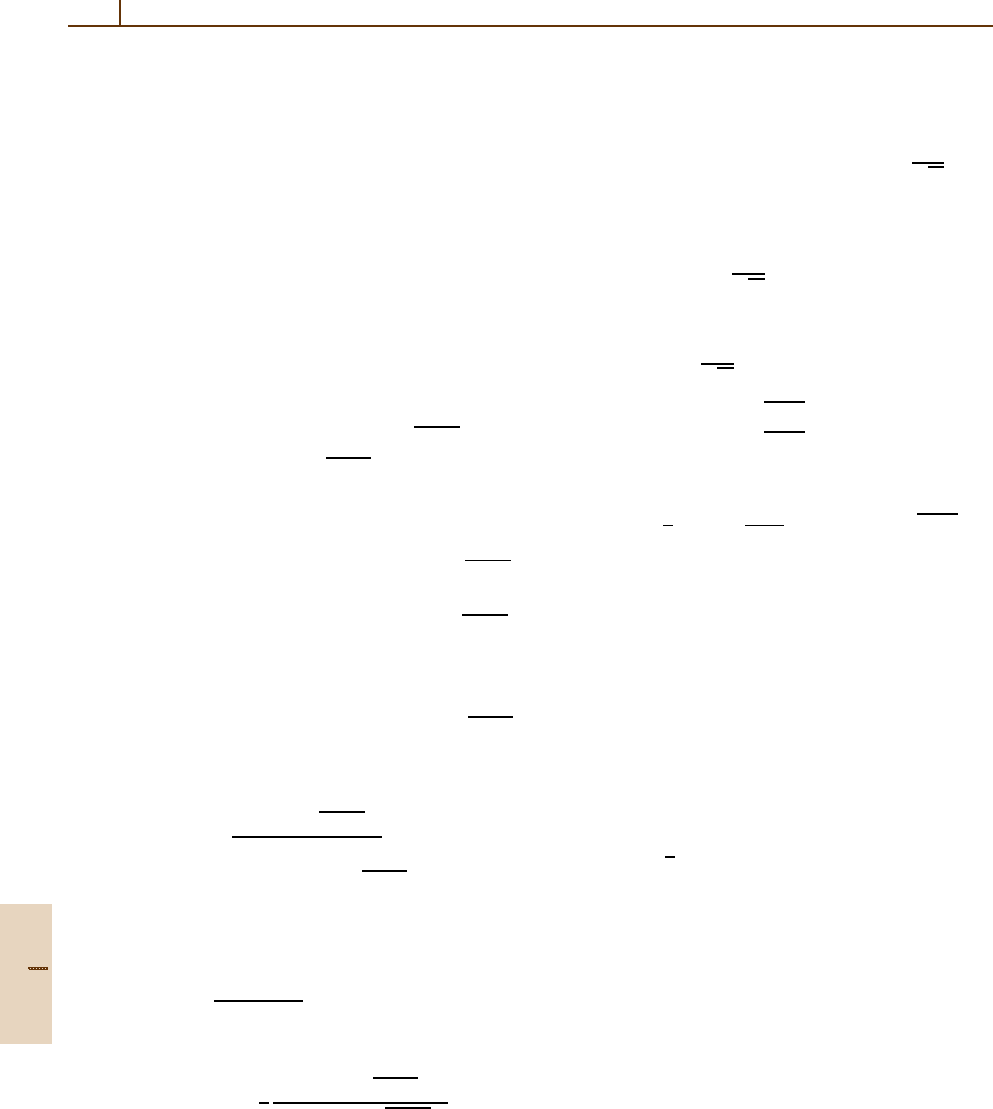
1176 Part F Quantum Optics
79.5.2 Fock States, Coherent States
and Thermal States
We now illustrate the properties of the Jaynes–
Cummings model by specifying the initial state. Assume
that the atom and field are brought into contact at time
t = 0 and that all correlations that might exist due to
previous interactions are suppressed.
Rabi Oscillations
If the atom is initially in the excited state and the field
contains precisely m quanta, then
C
j
n
(t = 0) = δ
n,m
δ
j,2
. (79.40)
The solution of (79.34) assumes the form
|Ψ(t)=e
−iω
µ
(m+1/2)t
cos
g
µ
√
m +1 t
|m;2
−i sin
g
µ
√
m +1 t
|m +1;1
. (79.41)
The occupation probabilities of the atomic states evolve
in time according to
n
2
(t) =Ψ(t)|22|Ψ(t)=cos
2
g
µ
√
m +1 t
,
(79.42)
n
1
(t) =Ψ(t)|11|Ψ(t)=sin
2
g
µ
√
m +1 t
.
(79.43)
The photon number and its variance are
n(t)=
Ψ(t)a
†
aΨ(t)
= m +sin
2
g
µ
√
m +1 t
,
(79.44)
∆
2
n=
Ψ(t)
a
†
a−
a
†
a
2
Ψ(t)
=
sin
2
2g
µ
√
m +1 t
4
.
(79.45)
In the limit of large m, g
µ
√
m +1 is proportional to
the field amplitude and the classical Rabi oscillations in
a resonant field are recovered. The nonclassical features
of the states are characterized by Mandel’s parameter
Q
M
=
∆
2
n
−n
n
≥−1 .
(79.46)
For the present example,
Q
M
=−1 +
1
4
sin
2
2g
µ
√
m +1 t
m +sin
2
g
µ
√
m +1 t
.
(79.47)
Q
M
≥ 0 indicates the classical regime, while Q ≤ 0 can
only be reached by a quantum process.
The Coherent State
Consider the case where the field is initially prepared in
a coherent state
|α=exp
αa
†
−α
∗
a
|0=e
−|α|
2
/2
∞
n=0
α
n
√
n!
|n ,
(79.48)
while the atom starts from the excited state
C
j
n
(0) = e
−|α|
2
/2
|α|
n
√
n!
δ
j,2
. (79.49)
In this case, the general solution specializes to
|Ψ(t)=
∞
n=0
α
n
√
n!
e
−iω(n+1/2)t
e
−|α|
2
/2
×
cos
g
µ
√
n +1 t
|n;2
−i sin
g
µ
√
n +1 t
|n+1;1
, (79.50)
and the occupation probability of the excited state is
n
2
(t) =
1
2
1+
∞
n=0
|α|
2n
n!
e
−|α|
2
cos
2g
µ
√
n +1 t
.
(79.51)
From here, detailed quantitative results can only be
obtained by numerical methods [79.41]. However, if
the coherent state contains a large number of photons
|α|
2
1, the essential dynamics can be determined by
elementary methods. Initially, the population oscillates
with the Rabi frequency Ω
1
≈ g
µ
|α|, which is propor-
tional to the average amplitude of the field, as expected
from its classical counterpart. With increasing time, the
coherent oscillations tend to cancel due to the destruc-
tive interference of the different Rabi frequencies in the
sum:
n
2
(t) =
1
2
1 +cos(2g
µ
|α|t)e
−(gt)
2
/2
.
(79.52)
However, strictly aperiodic relaxation of n
2
(t) is impos-
sible since the exact expressions, (79.36)and(79.37),
represent a quasiperiodic function which, given enough
time, approaches its initial value with arbitrary accuracy.
For short times, the oscillating terms in the sum
cancel each other due to the slow evolution of their
frequency with n. However, consecutive terms interfere
constructively for larger times t
r
, such that the phases
satisfy
φ
n+1
(t
r
) −φ
n
(t
r
) = 2π. (79.53)
For |α|
2
1, the increment of the arguments is
φ
n+1
−φ
n
= g
µ
t
r
/|α| , (79.54)
Part F 79.5
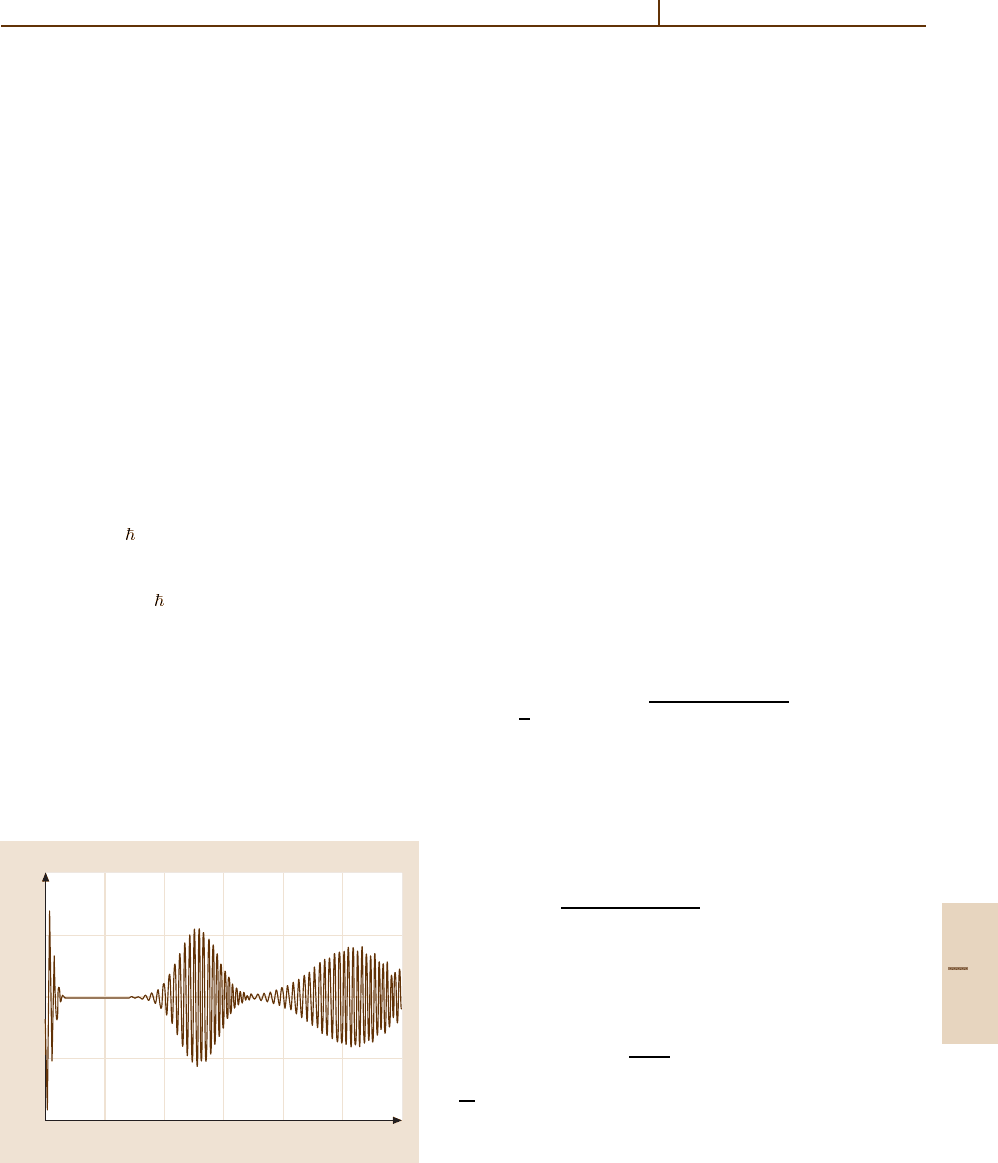
Entangled Atoms and Fields: Cavity QED 79.5 Microscopic Masers and Lasers 1177
and therefore the first revival of the Rabi oscillations
occurs approximately at t
r
= π|α|/g
µ
. A clear distinc-
tion of Rabi oscillation, collapses, and revivals requires
a clear separation of the three time scales
t
1
t
2
t
3
, (79.55)
where t
1
≈ (g
µ
|α|)
−1
for Rabi oscillation, t
2
≈ g
−1
µ
for
collapse, and t
3
≈|α|/g
µ
for revival.
The typical features of the transient evolution start-
ing from a coherent state are shown in Fig. 79.7. With
time increasing even further, revivals of higher order oc-
cur which spread in time, and finally can no longer be
separated order by order.
The Thermal State
Consider a microwave resonator brought into thermal
contact with a reservoir, inducing loss on a time scale
κ
−1
and thermal excitation. The dissipative time evolu-
tion is described by the master equation
˙
ρ =(L
0
+L)ρ
≡ i[H,ρ]/
+κ(n
th
+1)
a,ρa
†
+
aρ, a
†
+κn
th
a
†
,ρa
+
a
†
ρ, a
, (79.56)
where n
th
=[exp(β ω) −1]
−1
,atT = k
B
β
−1
,isthe
equilibrium population of the cavity mode, L
0
sym-
bolizes the unitary evolution according to the Jaynes–
Cummings dynamics and L is a dissipation term.
The solution of this model can be expressed in terms
of an eigenoperator expansion of the equation
Lρ =−λρ .
(79.57)
The eigenvalues λ that determine the relaxation rates, as
well as the eigenoperators, are known in closed form for
1
1.75
0.5
0.25
0
0 204060
gt
Population n
2
(t), α = 4
Fig. 79.7 Rabi oscillations, dephasing, and quantum revival
the case of vanishing temperature [79.42]. Since energy
is exchanged between the nondecaying atom and the
decaying cavity mode, cavity damping is modified in
a characteristic way due to the presence of the atom.
The technical details can be found in [79.43].
79.5.3 Vacuum Splitting
In the classical case, the eigenvalues of the interac-
tion free Hamiltonian are degenerate at resonance. The
atom–field interaction splits the eigenvalues and deter-
mines the Rabi frequency of oscillation between the two
states. One consequence is the existence of side bands
in the resonance fluorescence spectrum [79.44]. In the
quantum case, the field itself is treated as a quantized
dynamical variable determined from a self-consistent
solution for the complete system of atom plus field. The
vacuum Rabi frequency Ω
vac
= g
µ
remains finite, and
accounts for the spontaneous emission of radiation from
an excited atom placed in a vacuum. In the limiting case
of a single atom interacting with the quantized field,
the photon number n can only change by ±1, and the
population oscillates with the frequency Ω(n) given by
(79.29). For an ensemble of N atoms, n can in principle
change by up to ±N. However, if the field and atoms are
only weakly excited, the collective frequency of the en-
semble is determined by the linearized Maxwell–Bloch
equations. The eigenfrequencies are given by
λ
±
=
1
2
i(γ
⊥
+κ) ±
4g
2
µ
N −(γ
⊥
−κ)
2
,
(79.58)
where γ
−1
⊥
is the phase relaxation time of the atom and
κ
−1
the decay time of the resonator. This is the polariton
dispersion relation in the neighborhood of the polariton
gap. The spectral transmission
T(ω) = T
0
κ[γ +i(ω
0
−ω)]
(ω −λ
+
)(ω −λ
−
)
2
(79.59)
of an optical cavity containing a resonant atomic en-
semble of N atoms reveals the internal dynamics of the
coupled system and a splitting of the resonance line
occurs. T
0
is the peak transmission of the empty cav-
ity. The splitting increases either with the number of
photons, approaching
√
n +1 in the presence of a sin-
gle atom, or with the number of atoms, approaching
√
N in the resonator when the field is weak. The latter
case is demonstrated in Fig. 79.8 [79.34] for an optical
resonator with 1–10 atoms interacting with a field that
contains, on average, much less than a single photon.
Part F 79.5
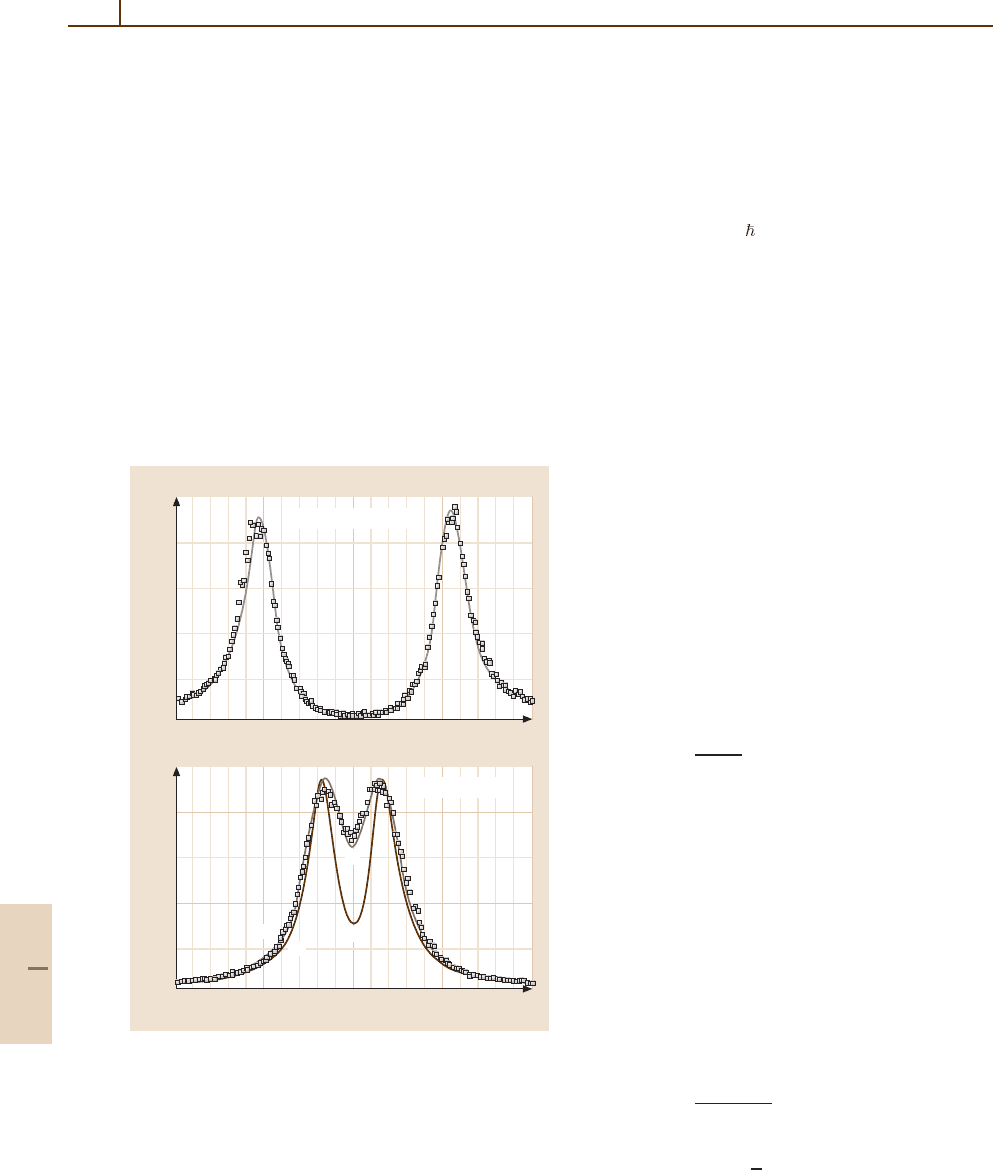
1178 Part F Quantum Optics
79.6 Micromasers
Sustained oscillations of a cavity mode in a microwave
resonator can be achieved by a weak beam of Rydberg
atoms excited to the upper level of a resonant transi-
tion. For a cavity with a Q ≈ 10
10
, much less than
a single atom at a time, on average, suffices to bal-
ance the cavity losses. Operation of a single atom maser
has been demonstrated [79.8]. The atoms enter the cav-
ity at random times, according to the Poisson statistics
of a thermal beam, and interact with the field only for
a limited time. In order to restrict the fluctuations of the
atomic transit time, the velocity spread is reduced. This
is achieved either by Fizeau chopping techniques, or by
making use of Doppler velocity selection in the initial
laser excitation process. Since most of the time no atom
is present, it is natural to separate the dynamics into two
0.05
0
0.10
0.05
0
–20 –10 0 10 20
–20 –10 0 10 20
n
Frequency (MHz)
N
= 10.7 atoms
n
Frequency (MHz)
N
= 1.0 atoms
(i)
(ii)
(ii)
(i)
Fig. 79.8 Intracavity photon number (measured from
a transmission experiment, [79.34]) as a function of probe
frequency detuning, and for two values of N, the average
number of atoms in the mode. Thin lines give theoretical fits
to the data, including atomic number and position fluctua-
tions. Curve(ii) in the lowergraph is for a single intracavity
atom with optimal coupling g
µ
parts [79.45]:
1. For the short time while an atom is present, the
state evolves according to the Jaynes–Cummings
dynamics, where H is defined in (79.33),
˙
ρ(t) = i[H,ρ]/
, (79.60)
and damping can safely be neglected. The formal
solution is abbreviated by ρ(t) = F(t −t
0
)ρ(t
0
).
2. During the time interval between successive atoms,
the cavity field relaxes freely toward the thermal
equilibrium according to (79.56) with L
0
= 0:
˙
ρ(t) = Lρ,
(79.61)
with the formal solution ρ(t) =exp[L(t −t
0
)]ρ(t
0
).
The time development of the micromaser therefore
consists of an alternating sequence of unitary F(t) and
dissipative e
(Lt)
evolutions. Atoms enter the cavity one
by one at random times t
i
. Until the next atom enters at
time t
i+1
, the evolution t
i
is given by
ρ(t
i+1
) = exp(Lt
p
)F(τ)ρ(t
i
), (79.62)
where t
p
= t
i+1
−t
i
−τ,andτ is the transit time.
If τ t
i+1
−t
i
on average, then t
p
≈ t
i+1
−t
i
.Af-
ter averaging (79.62) over the Poisson distribution
P(t) = R exp(−Rt
p
) for t
p
,whereR is the injection
rate, the mean propagator from atom to atom is
ρ(t
i+1
)=
R
R−L
F(τ)ρ(t
i
) . (79.63)
After excitation, the reduced density matrix of the
field alone becomes diagonal after several relaxation
times κ
−1
:
n|Tr
atom
(ρ)|m=P
n
δ
n,m
. (79.64)
Due to the continuous injection of atoms, the field
never becomes time independent, but may relax toward
a stroboscopic state defined by
ρ(t
i+1
)=ρ(t
i
) . (79.65)
The state of the cavity field can be determined in closed
form by iteration:
P
n
= N
n
k=1
n
th
κ + A
k
(n
th
+1)κ
,
(79.66)
where N guarantees normalization of the trace and
A
k
=(R/n) sin
2
(g
µ
τ
√
n), and exact resonance between
Part F 79.6
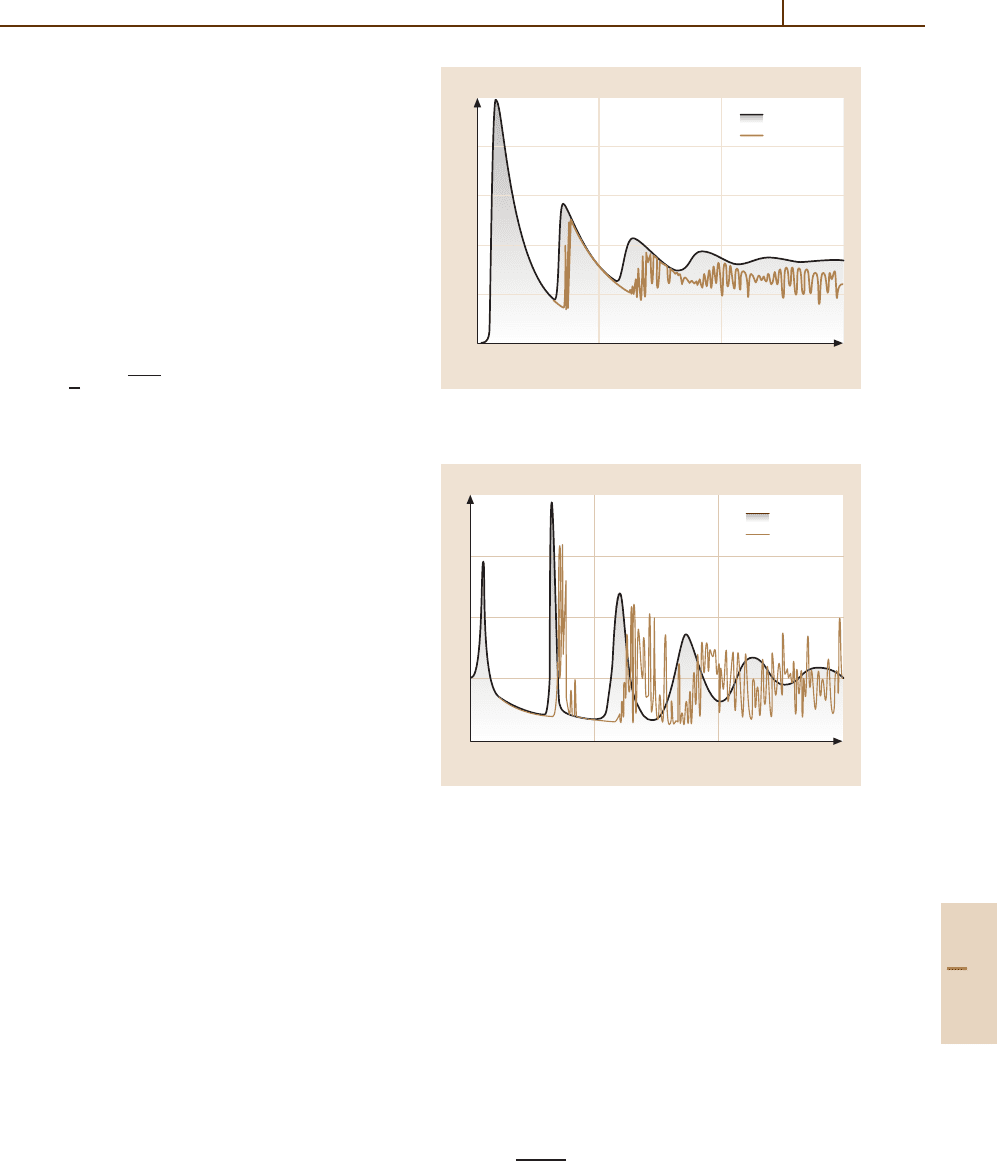
Entangled Atoms and Fields: Cavity QED 79.6 Micromasers 1179
cavity mode and atom is assumed. Since all off-diagonal
elements vanish in steady state, (79.66) provides a com-
plete description for the photon statistics of the field.
79.6.1 Maser Threshold
The steady state distribution determines the mean photon
number of the resonator as a function of the operating
conditions:
n=
∞
n=0
nP
n
. (79.67)
A suitable dimensionless control parameter is
Θ =
1
2
g
µ
τ
R/κ . (79.68)
For Θ 1, the energy input is insufficient to coun-
terbalance the loss of the cavity, effectively resulting
in a negligible photon number. With increasing pump
rate R, a threshold is reached at Θ 1, where n in-
creases rapidly with R. In contrast to the behavior of
the usual laser, the single atom maser displays multi-
ple thresholds with a sequence of minima and maxima
of n as a function of Θ [79.46]. This can be related
to the rotation of the atomic Bloch vector. When the
atom undergoes a rotation of about π during the transit
time τ, a maximum of energy is transferred to the cavity
and n is maximized. The converse applies if the aver-
age rotation is a multiple of 2π.Thisbehaviorisshown
in Fig. 79.9. The minima in n are at Θ 2nπ.
79.6.2 Nonclassical Features of the Field
Fluctuations can be of classical or of quantum origin.
The variance of the photon number
σ
2
=
n
2
−n
2
(79.69)
is a measure of the randomness of the field intensity.
Classical Poisson statistics require that σ
2
≥n .Avalue
below unity indicates quantum behavior, which has no
classical analog. In Fig. 79.10, the variance is plotted
as a function of Θ. Regions of enhanced fluctuations
σ
2
> n alternate with regions with sub-Poissonian
character σ
2
< n [79.47]. When n approaches a lo-
cal maximum it is accompanied by large fluctuations,
while at points of minimum field strength the fluctua-
tions are reduced below the classical limit. This feature
is repeated with a period of Θ 2π, but finally washes
out at large values of Θ.
The large variance of n is caused by a splitting of
the photon distribution P
n
into two peaks, which gives
1
0.8
0.6
0.4
0.2
0
0 5 10 15
Average photon number <n>
Normalized transittime Θ
n
th
= 0
n
th
= 0.1
Fig. 79.9 Average photon number as a function of the
normalized transit time defined by (79.68)
4
3
2
1
0
0 5 10 15
Variance of photon number distribution
Normalized transittime Θ
n
th
= 0
n
th
= 0.1
Fig. 79.10 Variance normalized on the average photon
number σ
2<n >
/σ. Values below unity indicate regions
of nonclassical behavior
rise to bistability in the transient response [79.48]. The
sub-Poissonian behavior of the field is reflected in an
increased regularity of the atoms leaving the cavity in
the ground state.
79.6.3 Trapping States
If cavity losses are neglected, operating conditions exist
which lead directly to nonclassical, i. e., Fock states. If
the cavity contains precisely n
q
photons, an atom that
enters the resonator in the excited state leaves it again in
the same state provided the condition [79.49]
g
µ
τ
n
q
+1 = 2qπ (79.70)
Part F 79.6
